
John Sheeran
This photo shows Ed rehearsing at Wembley Stadium the day before the biggest gig of his life. No one had ever played Wembley entirely solo before. It is difficult to imagine how daunting a prospect this must have seemed to Ed at this particular moment, standing at the front of a vast empty stage, facing tens of thousands of empty seats.
— LONDON, 9 JULY 2015 —

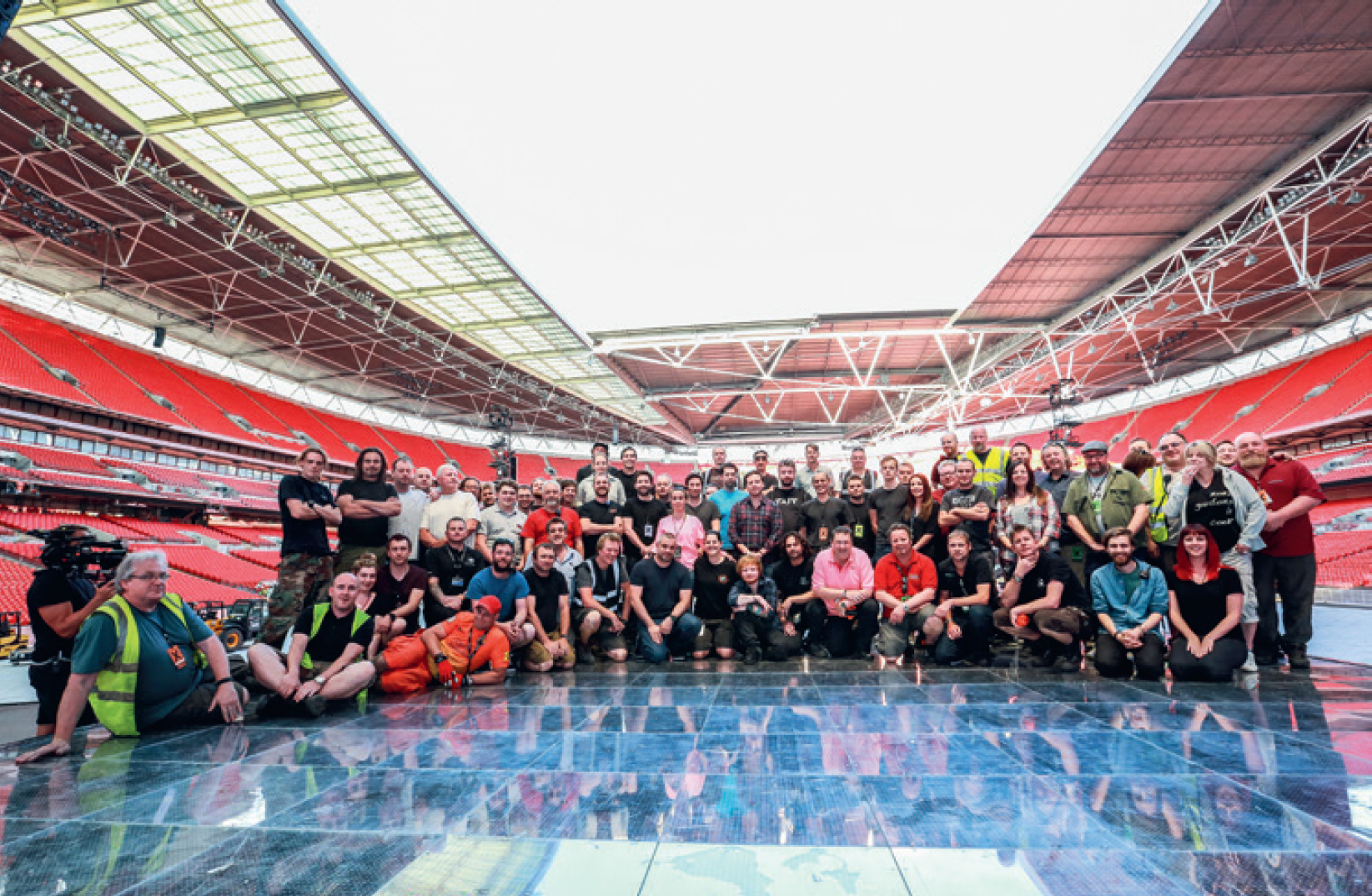
John Sheeran
Here is a photo of Ed’s management and crew, many of whom tour the world with him for months on end. They are an extraordinary team, able to work under intense pressure day in, day out, from city to city. They are like one big family, doing fantastic professional teamwork in a positive spirit. Like Ed, for many of them Wembley Stadium in 2015 represented the summit of their careers. I think this group shot wonderfully captures their sense of collective pride and achievement. I can imagine how difficult it must have been to get everyone together for this photo.

I was 14 when I got my very first camera, back in the late 1970s, a Carena 35mm SLR. My daddy bought me this camera because I used to run off with his camera, which he didn’t like very much. He was a captain-at-sea, and often I joined him on his round-the-world voyages.
I remember how with my very first roll of film I shot some seagulls that flocked around my dad’s ship. As soon I had snapped up the 24 frames on the film, I was impatient to have it developed and see if anything good had come out of it. I still remember the moment I opened the pouch, and the first picture in the pile was a close-up of this majestic wide-winged seagull flying dead centre of my frame. When you looked at it, it made you feel as if it was going to fly right into you. I remember staring at the picture– in awe that I had captured that one-fifteenth of a second in time of a seagull’s flight. And that very first picture from that very first film roll is still the reason why I am taking pictures today. To stop time and grasp that one still moment forever – to admire, remember and reminisce.
Fast forward more than 40 years. Many of the jobs I get are last minute. Nobody hires the photographer first. I knew I wanted to be at Wembley with Ed, and I had a gut feeling the call would come. I had several shoots already lined up, but my manager had the same gut feeling and had kept the day of rehearsals and the day of the first show off the books just in case we got the call. And the call came, just two days before Ed’s groundbreaking and record-breaking three nights at Wembley Stadium. Ed’s manager Stuart Camp basically said I would be responsible for shooting everything, and for delivering photos to his label and the media. Stuart and Ed trusted me to get on with it – it was one thing less for them to worry about.

Disappointingly, I wasn’t available the other two nights, so I really had to get it right the first time. There would be no second chances. As you can imagine, the thought of being able to record hundreds of moments of what would probably be the defining highlight in Ed’s career was both a thrill and an honour.
On the day of the rehearsals we arrived quite early at Wembley Stadium, and as soon as I had walked onto the field, covered in huge metal sheets, it hit me how big this event was going to be. There were crew busy everywhere, finishing the work on the stage, pulling up the lighting rigs, dragging around sound monitors. Forklifts were scurrying over the field, vans kept driving in and out. It was an overwhelming sight. I stood there in the middle of it all with my two cameras, which all of a sudden seemed incredibly tiny, just like me. I was in awe and I couldn’t help but feel intimidated by it all. This was it. The next day, on Friday night, Wembley Stadium was going to be packed with 90,000 people to watch one man with a guitar and a loop pedal board single-handedly entertain the crowd for two hours. How amazing was that?
We ran into Mark and Stuart, who explained to us what was happening that day and where I would be shooting from. The beauty was that I pretty much had complete freedom and was allowed to shoot from pretty much anywhere – as long as I got the shots. It was music to my ears.
Ed arrived soon after and walked over the field to look up at the majestic stage – his stage. He turned to us and came over and said hello. We hugged. I asked him if he felt nervous, and he just smiled and said, “Not at all . . . yet.” I thought he was awfully brave, as I felt nervous and I wasn’t the one who had to entertain such a large crowd the following day. I could hide behind my cameras.
I never take pictures of myself with the artist I work for. The artist is the client and I’m the photographer. Do you take selfies with your doctor when you go for a check-up? Exactly! But that day Patrick insisted he take a shot of me and Ed together to document the moment. I reluctantly obliged. Ed then walked around to the back of the stage and walked up the ramp, and I followed him like a little puppy dog. Trevor, Ed’s guitar tech, came to hand him his guitar and together they went over a couple of details. Trevor remained by Ed’s side while Ed hit his first chords. The sound check with Ed was the ideal time for me to shoot some clean shots on that magnificent stage in that impressive stadium in broad daylight.
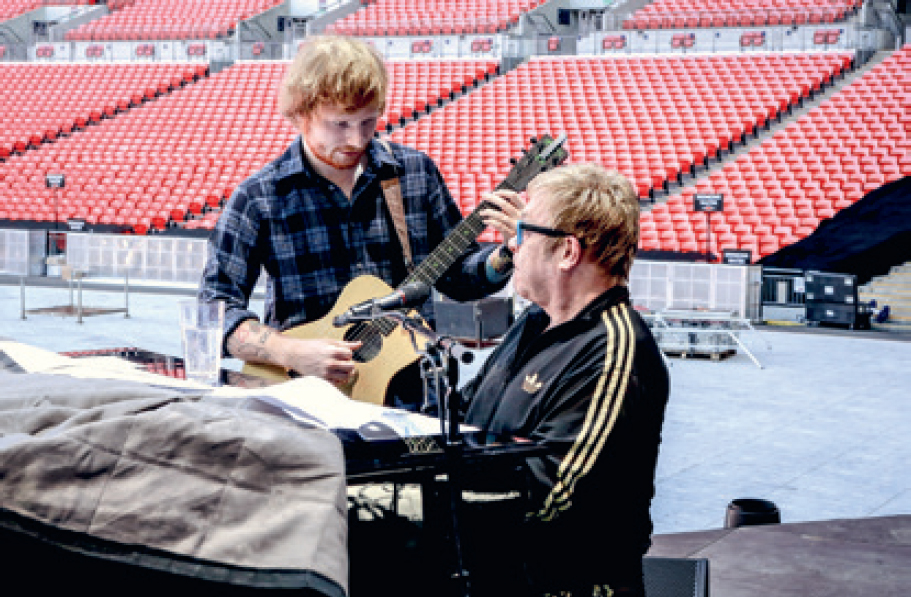
John Sheeran
I am so pleased that we selected Christie’s photos of Ed rehearsing and performing with Elton John at Wembley Stadium for this book. Elton has had a profound influence on Ed as a trusted mentor over several years, encouraging and supporting him. Imogen and I cannot thank him enough. Ed has learned so much from him about developing his career, navigating the machinations of the music industry, and coping with the negative aspects of fame. You can tell from these photos that Ed and Elton have a strong professional respect for each other, and a very close personal bond and friendship. They are rehearsing two songs – one by Elton, “Don’t Go Breaking My Heart”, originally a duet with Kiki Dee, and one by Ed, “Afire Love”, written as a moving memorial to his grandfather, my father, who died in 2013. The rehearsal photos reveal their serious intent, as they are both determined to achieve the best for each other. The shot of Ed walking away from Elton back to his microphone shows his absolute focus and concentration on the task in hand. And then, when the rehearsal is over and they can relax, Ed gives Elton an all-embracing thank-you hug.
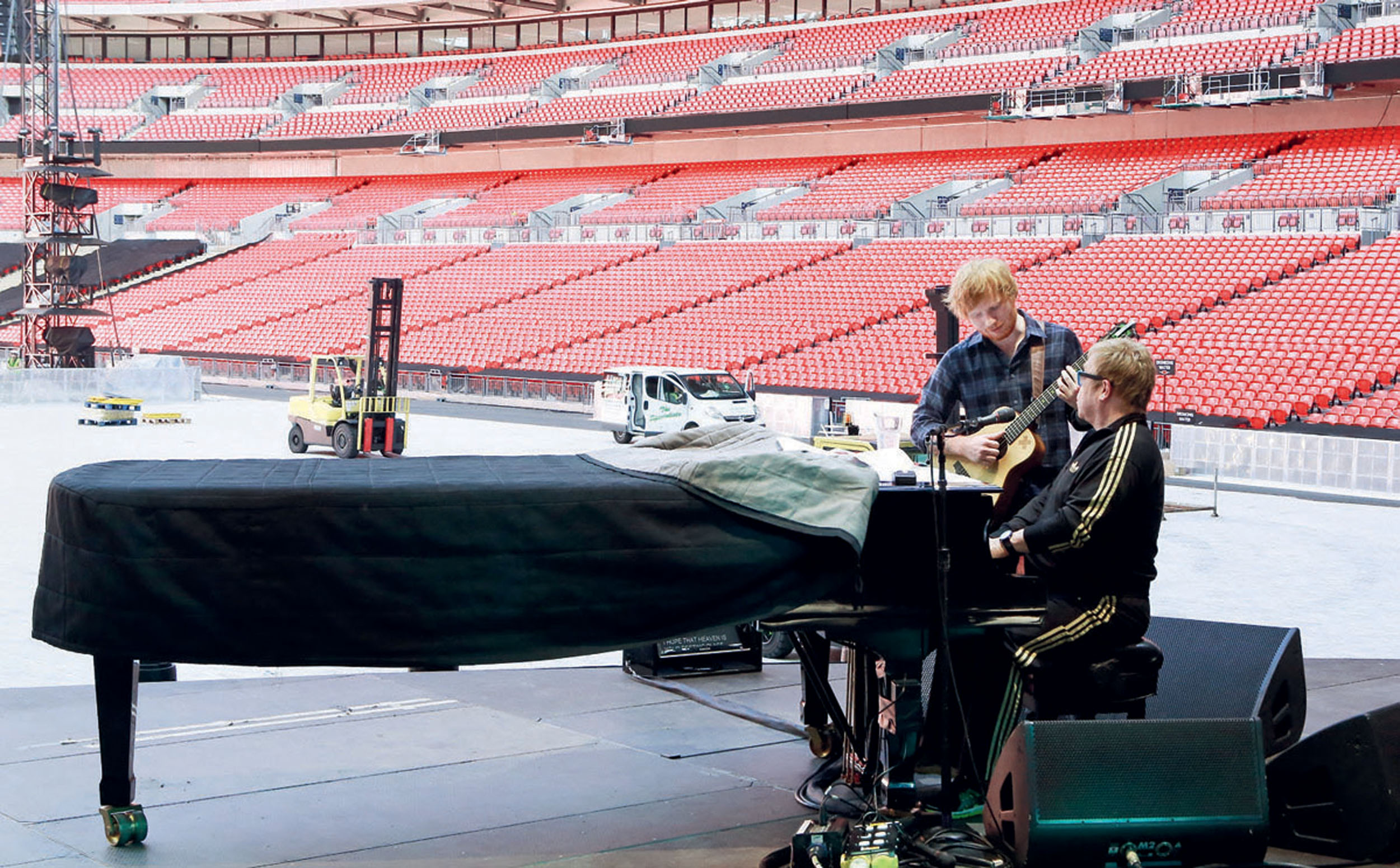
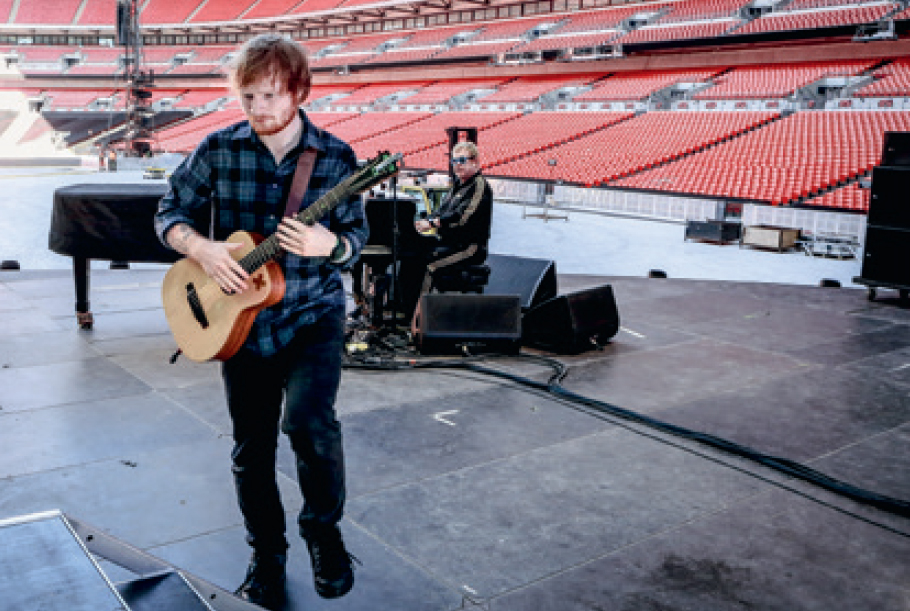
Suddenly, Elton John appeared out of nowhere and went to sit behind his piano. I had wondered why that piano was there. He waved and Ed walked over to hug his friend. They had a little chat, Ed took up his guitar, and together they started figuring out how they were going to perform a unique rendition of “Don’t Go Breaking My Heart”, Elton’s famous duet with Kiki Dee. I kept shooting, but a few minutes later I just couldn’t help myself, I just had to tap and sing along.
After the sound check Mark gathered the whole Ed Sheeran team together for a group photo on stage. People kept popping up and Mark kept telling me, “Not yet . . . we’re still waiting for someone.” In the end, it was quite an impressive group. Some of the faces onstage I knew, they had been with Ed for years. I was pleased not just for me, but for them as well, that I could capture all the people together who had made this event happen, on such a majestic stage, with the epic stadium behind them. You don’t always realize when you attend a performance how many people behind the scenes have busted their arses off to make it all happen. Each and every one of them has a crucial role in bringing the show to life. It also struck me how everyone was quite calm, but, like they say, calm before the storm.
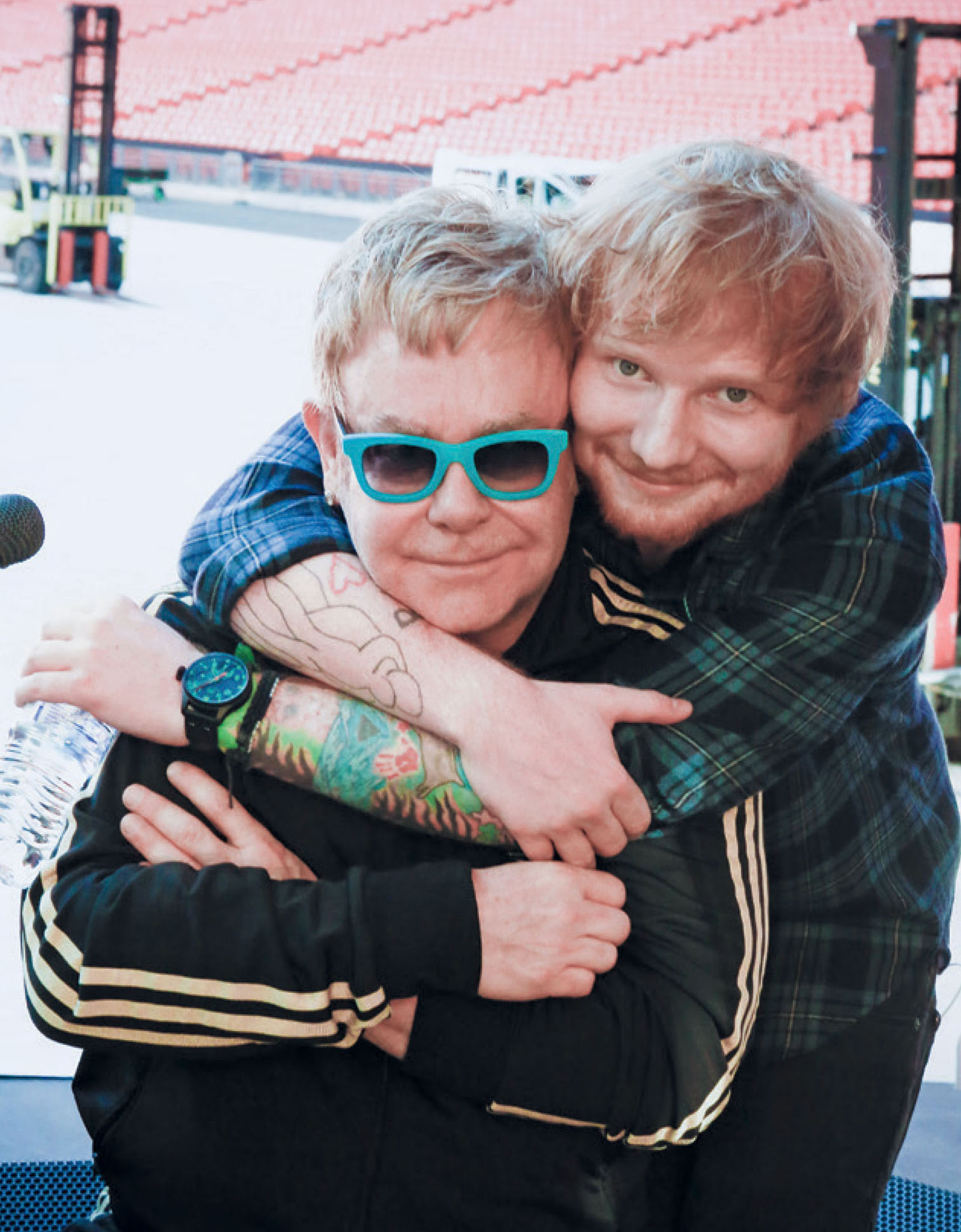
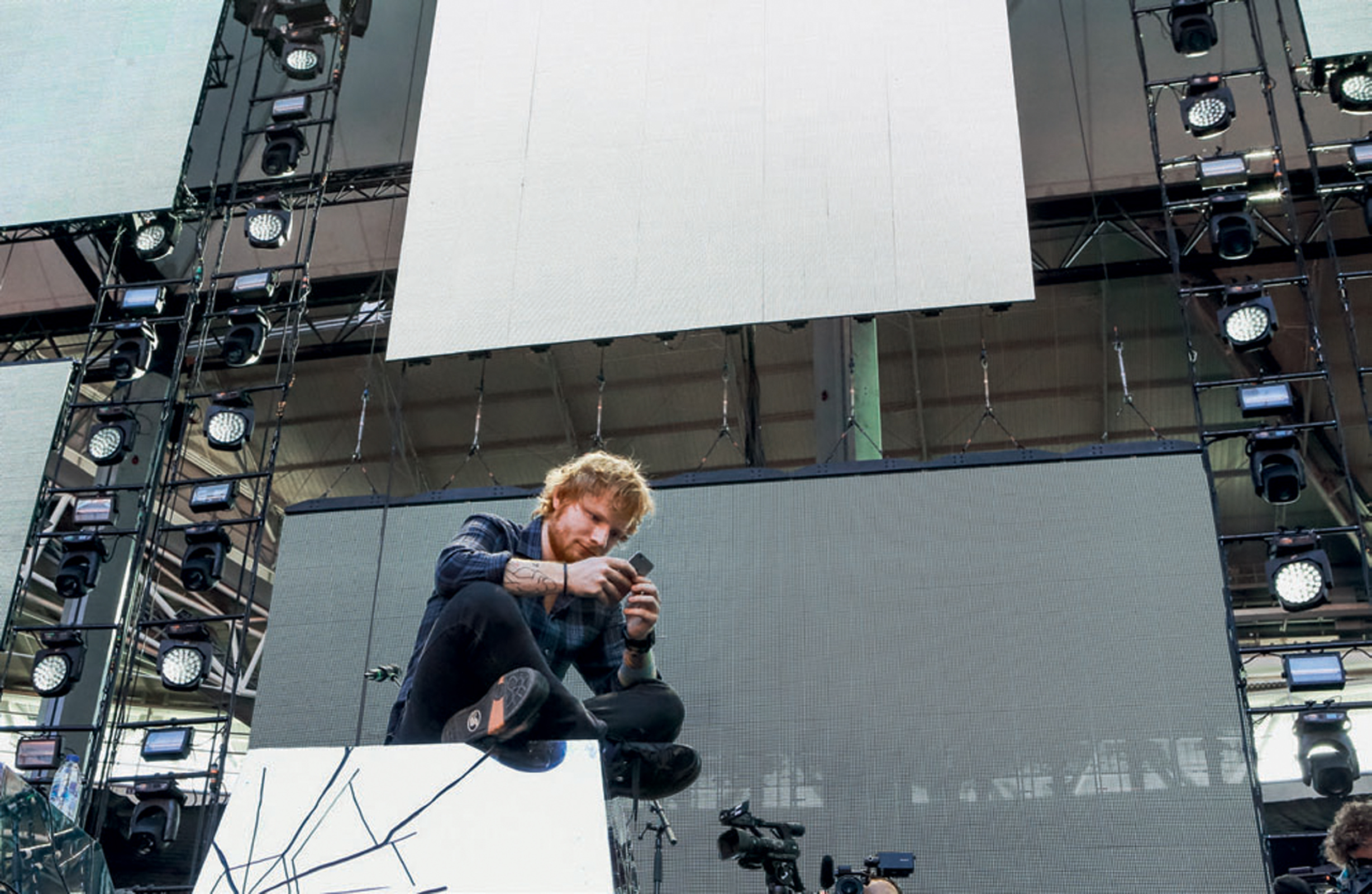
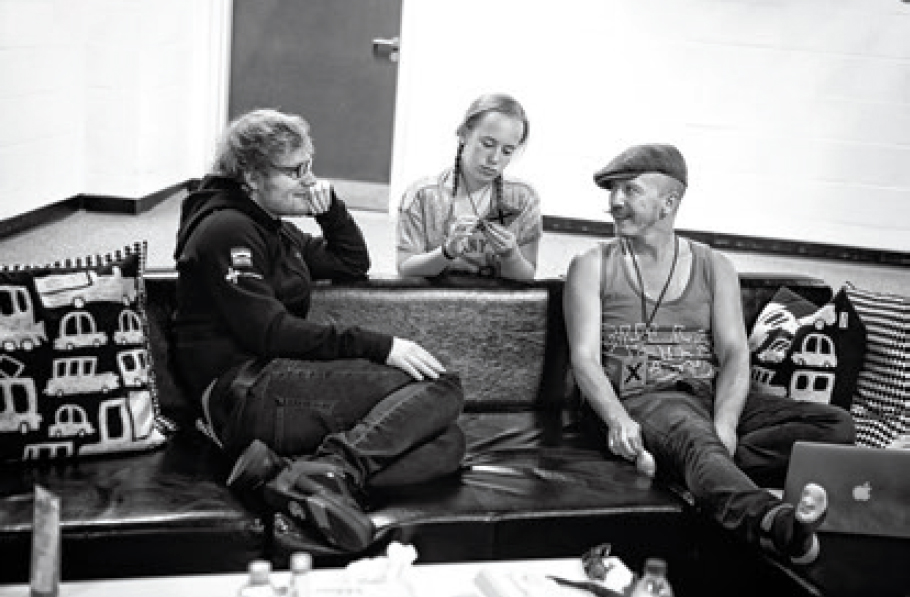
John Sheeran
Ed rates Foy Vance as one of the most gifted contemporary singer-songwriters and performers he has worked with. Foy is also one of the closest friends Ed has made in the music industry. They have worked together a great deal and there is a deep understanding, trust and respect between them. Ed especially admires Foy’s integrity as an artist. Here they are together with Ella, Foy’s wonderful daughter, relaxing in a dressing room at Wembley Stadium in 2015. Foy is about to go onstage as Ed’s support act. Rewind back to July 2007, when I drove Ed to the Wye Fayre festival, held in some fields in Kent (UK) where you could also camp. Foy was the last act to perform, around midnight. I remember Ed, aged 16, sitting cross-legged on the grass, just a few feet away from Foy, completely spellbound by his performance. It was definitely a light-bulb moment for him. From then on, he tried to get to as many Foy Vance gigs as he could. In November 2015 Foy signed to Ed’s record label, Gingerbread Man Records.

The following day the atmosphere was quite different. We walked up to the stadium in the early afternoon and there were already thousands of fans around. At the sides of Olympic Way, the avenue that connects Wembley Park underground station with Wembley Stadium, street vendors were selling all kinds of stuff, a lot of it with glitter and flickering lights. There were hot dog stands and ice cream vans. It felt like walking through a carnival. I noticed a lot of younger children accompanied by their parents. Ed attracts a wide range of fans.
Getting inside the building had become more complex as well. The stage entrance gate had been fenced and security went over my roller bag and handbag with a fine-tooth comb before I was allowed to enter. Inside the arena there were no workmen dragging stuff around and the forklifts were all parked nicely backstage. Instead, people were running around nervously, most of them with very serious faces. More security staff were at every entrance, every corner, every gate. This was no longer the calm; this was starting to feel like the storm.
We walked into the artist corridor and met with Mark, who handed me a series of passes I had to wear so I would have unobstructed access. I needed a pass to access the pit in front of the stage, but I also needed a different pass to access the stage itself. They wanted to keep the stage strictly off limits for anybody who didn’t need to be there. Everything was meticulously organized.
I hung around in the dressing room area for a bit but didn’t walk into Ed’s room. Ed was about to do the biggest gig of his life; he didn’t need me in there with him. Ed’s friend Foy Vance was the support act that day, and Foy’s manager had expressed interest in having me take some shots of the occasion, as I was there anyway. I knocked on Foy’s door and he waved me in and we took some candid portraits. Ed walked in a bit later for a chat with Foy. He still seemed quite calm and serene. A little later we ran into John and Imogen who were just making their way to their seats. We hugged and they were obviously excited to see their son achieve such a milestone in his career.
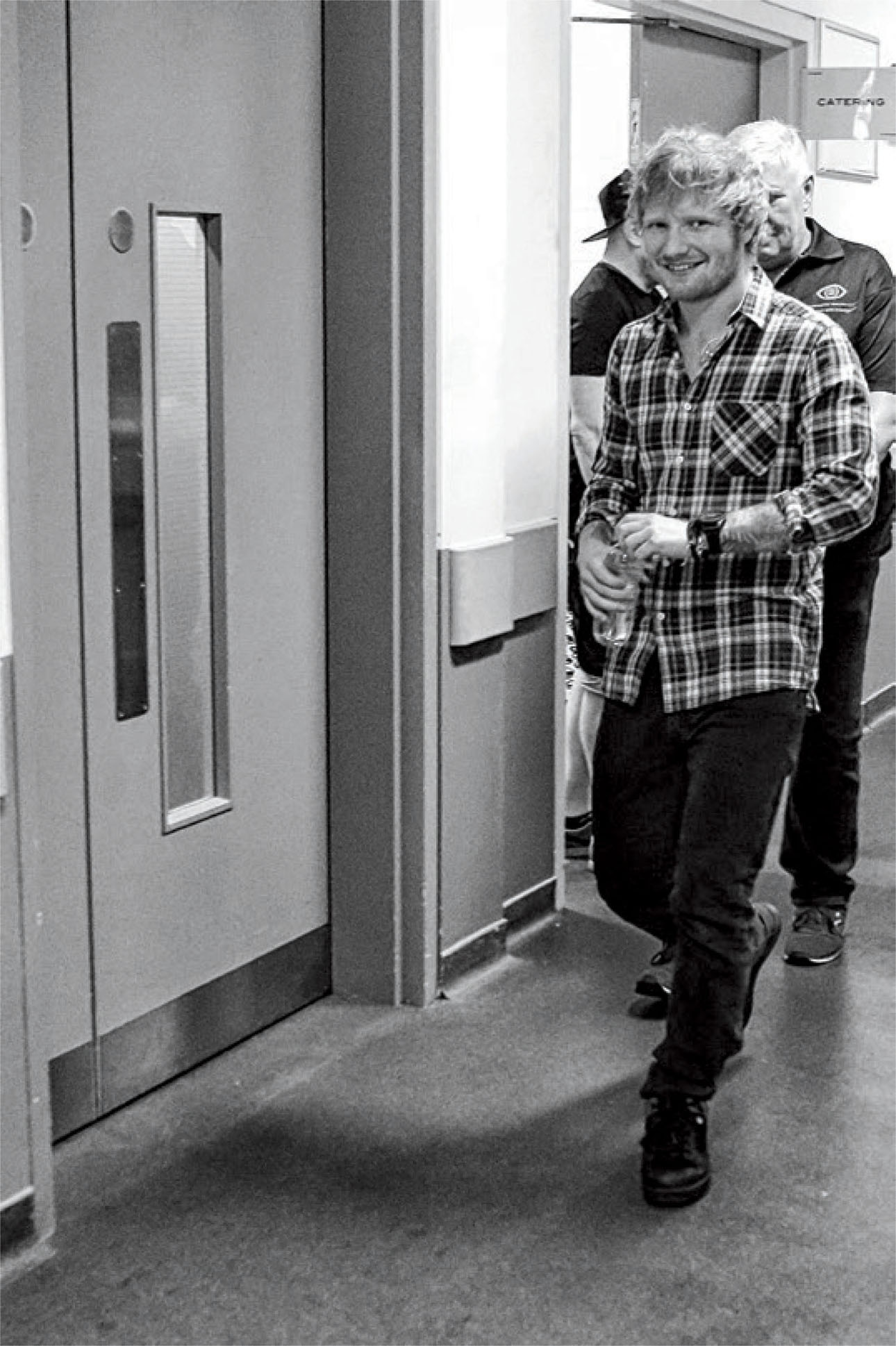
John Sheeran
These photos show Ed making his way from his dressing room to perform on the Wembley Stadium stage for the first time. To begin with it is all smiles, as Ed is accompanied by his security and his tour manager Mark Friend down the corridor. Then, as he strides purposefully through the parking and loading bay, you can sense the tension and nerves kicking in, as Ed can now hear the crowd. He doesn’t know whether he will be able to pull off a solo gig in front of 87,000 people, as it’s something he has never done before. As he reaches the bottom of the ramp up to the stage, he is greeted by his stage manager, Matthew Caley. They rap knuckles and Matthew looks into Ed’s eyes as if to say, “Good luck, mate. Just go for it.” Matthew and Ed have been working together for years. In the next shot, Ed and his manager Stuart have their arms around each other in a touching embrace, as Ed is offered some final words of encouragement. The two of them have been on an incredible journey together, and this is the climax of their achievement so far. Finally, in a slightly blurred shot, Ed emerges alone. We can see the crowd in the distance, and now it’s all up to him.
And then the time had come. Showtime! Ed left his dressing room and made his way to the stage with Mark and Stuart by his side. In the corridor, he smiled at everyone and waved to my camera as he passed by. Mark then led him under the north-west stands to the back of the stage. They stood still for a moment at the bottom of the ramp. The stage manager gave Ed some last-minute pointers, and they gave each other a fist bump. Ed and Stuart put their arms around each other’s shoulders for a second, and then Ed started his walk up on the ramp with Mark, followed by Stuart. I stood at the top of the ramp. I can’t even begin to imagine what must have been going through Ed’s head at that time. When he reached the top of the ramp he peeked over at the stage and saw his crowd for the first time. Trevor handed Ed his guitar. Ed was dead serious and looked into the packed stadium. Then, with a very determined step, he walked to the front of the stage. I snapped a few shots from up there as he launched into his gig and then I returned down the ramp to go to the pit in front of the stage.
I thought back to our very first meeting in that club above a pub in Camden where he played in front of no more than 25 people. Now he was here performing three sold-out nights at Wembley Stadium. I felt a little bit disappointed that I wouldn’t be able to cover the next two days because of those other commitments. I think I even asked Patrick that evening if there was any way that I could get out of them. I knew it wouldn’t be possible, and ordinarily I would never have done something like that, but just for a moment, I admit, I thought about it. I had to enjoy that night for all it was worth.
Once I had entered the pit, I had a bit of a struggle with the stupendous scale of it all. I don’t think I’ve ever felt so small as I did in front of that humongous stage. Me and my two photo cameras surrounded by 20-odd large film cameras placed all over, seriously obstructing my sight when they were rolling from left to right in front of the stage. The stage was so high that at times I could see only the top of Ed’s head.
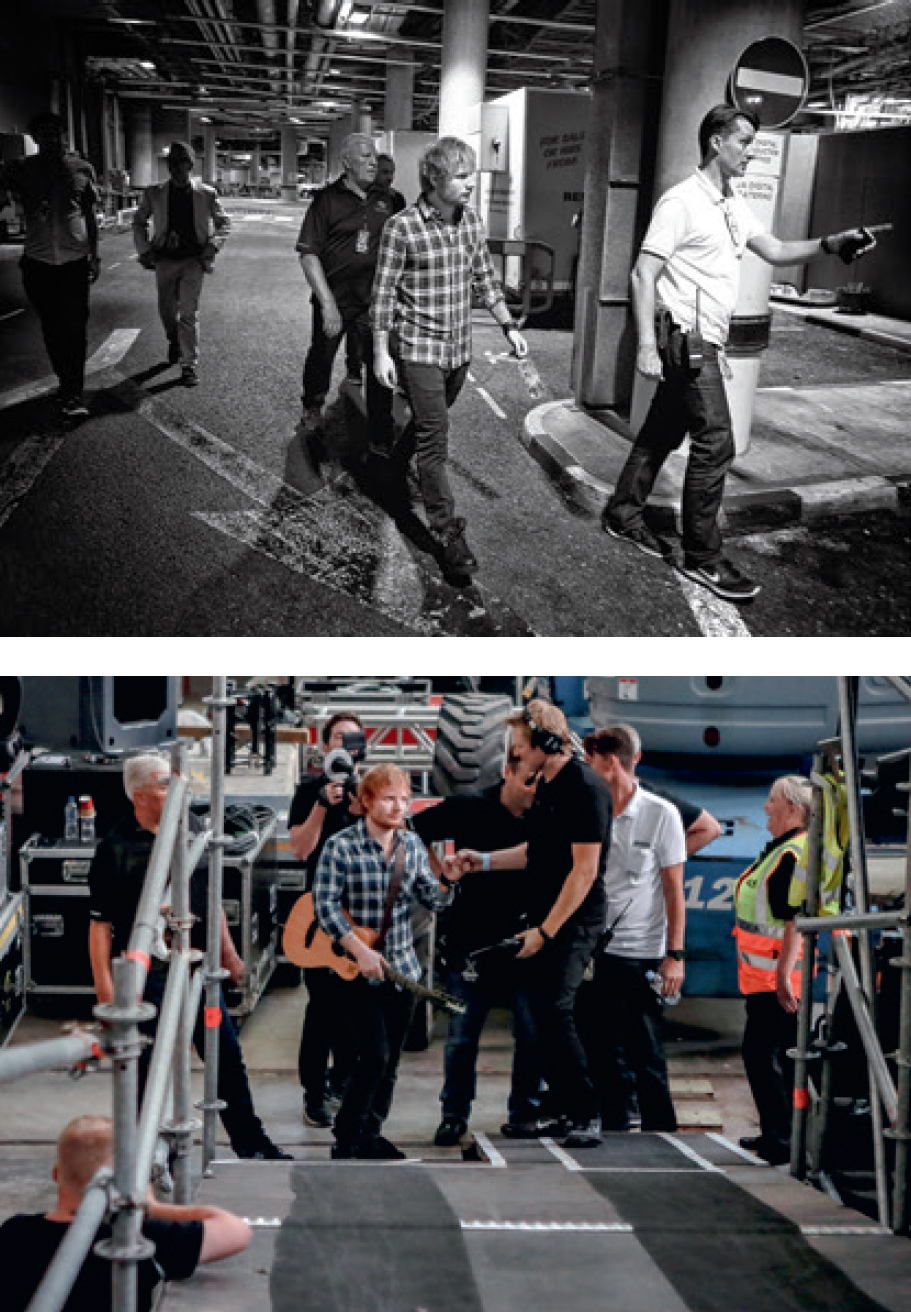
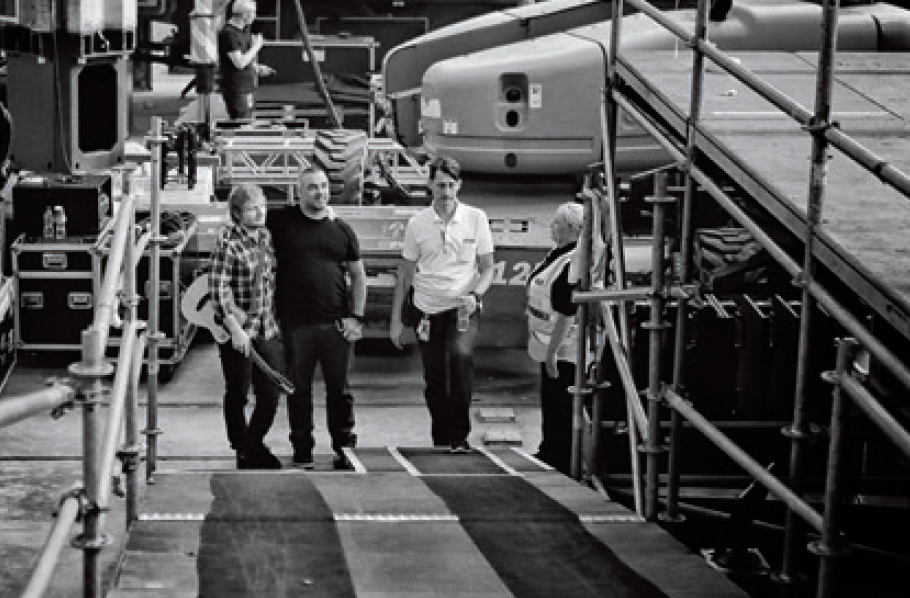
A dozen huge screens were placed at the back of the stage showing Ed with different colours and effects depending on the song and mood. The whole production was larger than life and I felt like a little mouse stuck in an elephant cage. But I couldn’t allow myself to panic or get irritated by those roving cameras blocking my view all the time. If Ed could handle it all by himself to entertain the crowd this size without the aid of pyrotechnics, special effects or gimmicks, then I, surely, could do my thing with my two little cameras. I apologize to my cameras calling them small but in the grand scale of things they were minuscule that day.
Halfway through the gig the audience were pleasantly surprised when Ed announced that he would be joined by Elton John. I had already decided to shoot their first song together from the pit and then to go back up to the stage to shoot them with the crowd as their background. At the end of their second song they hugged and Ed continued on his own.
Because my view from the pit was a bit unpredictable, I decided to stay onstage to try to get the perfect iconic Wembley Stadium shot I knew I needed. The sun had gone down by now and the spotlights were roving from left to right over the stage, so it took some patience and waiting for the right moment to get the shots I was after.
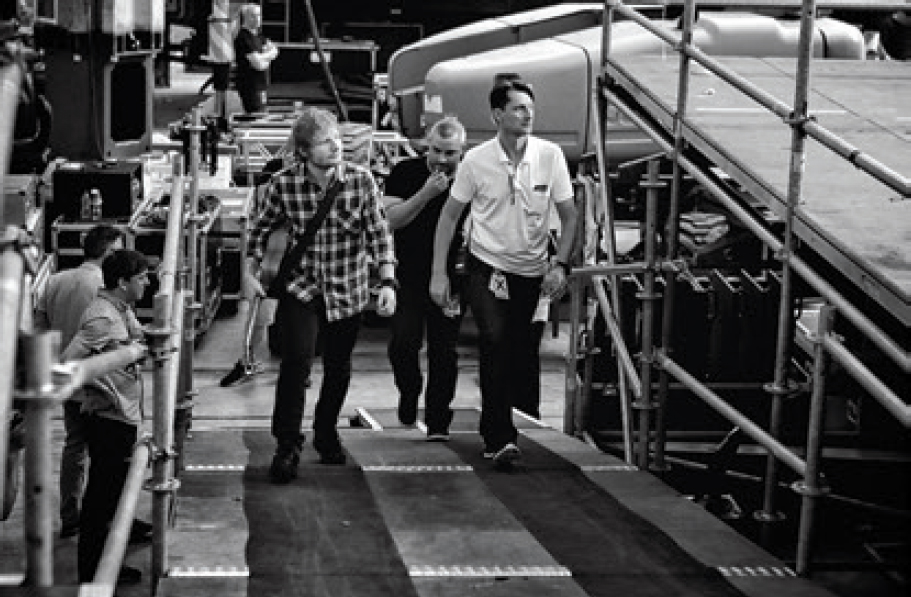
My highlight that evening was when Ed asked the crowd to hold their phone lights up. I remembered the moment during his Royal Albert Hall gig the year before, so I was ready to capture it. Instantly, the stadium was lit up with a sea of little star lights. Once again, it was tricky to capture as the stage was quite bright and the stadium, despite the phone lights, was quite dark. I kept scrolling my shutter speed from one side to the other and then there was this moment, as if all had gone quiet. The whole stadium was waving their lights – I held my camera very still, pushed the release button and I knew I had it. The shot that would tell the story of that night. The story of that monumental moment for Ed, proof of how far he had come. Before he left the stage, Ed told the crowd, “I will never forget this.” And I thought to myself, “You and me both, my friend, you and me both.”
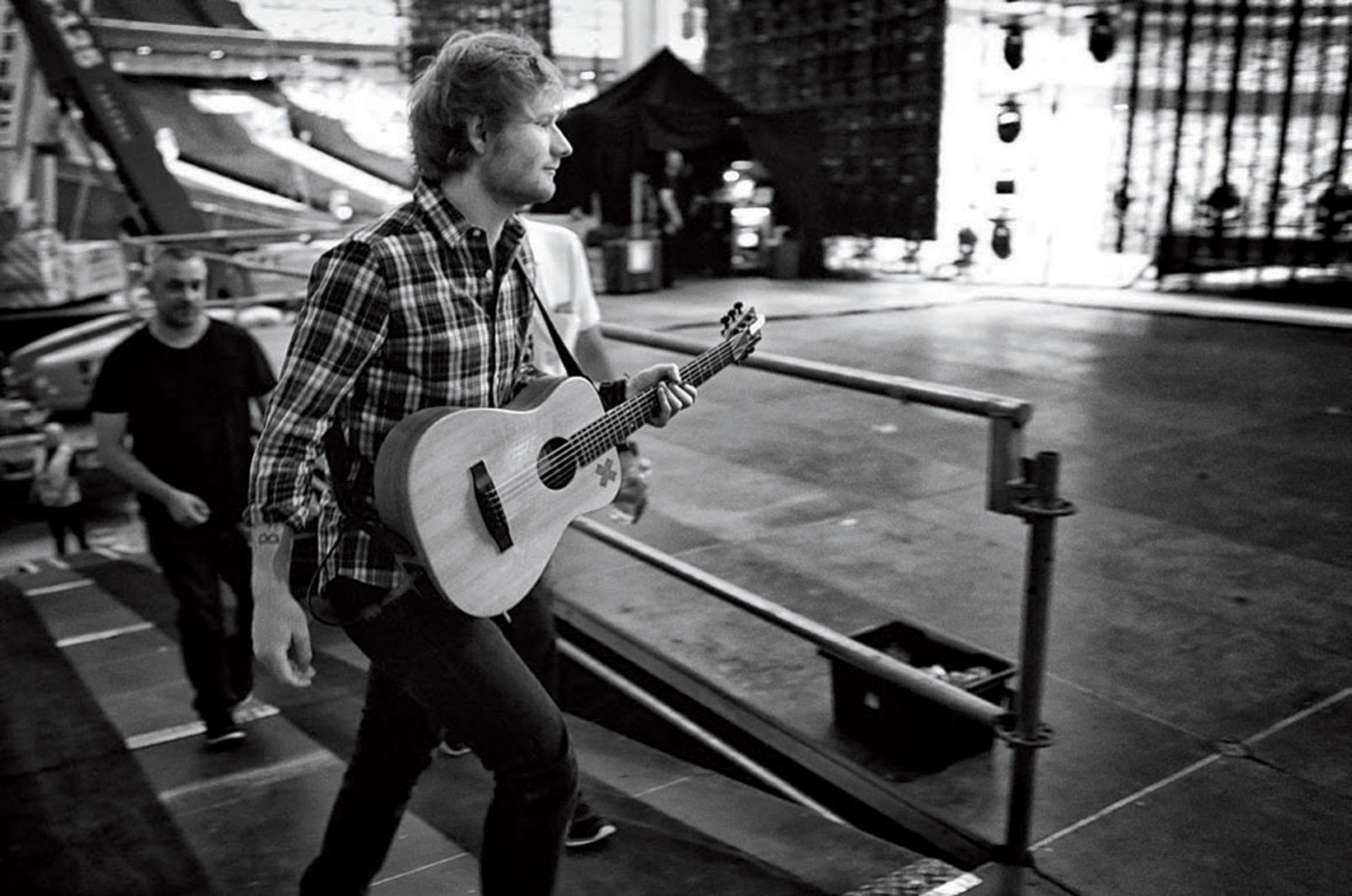
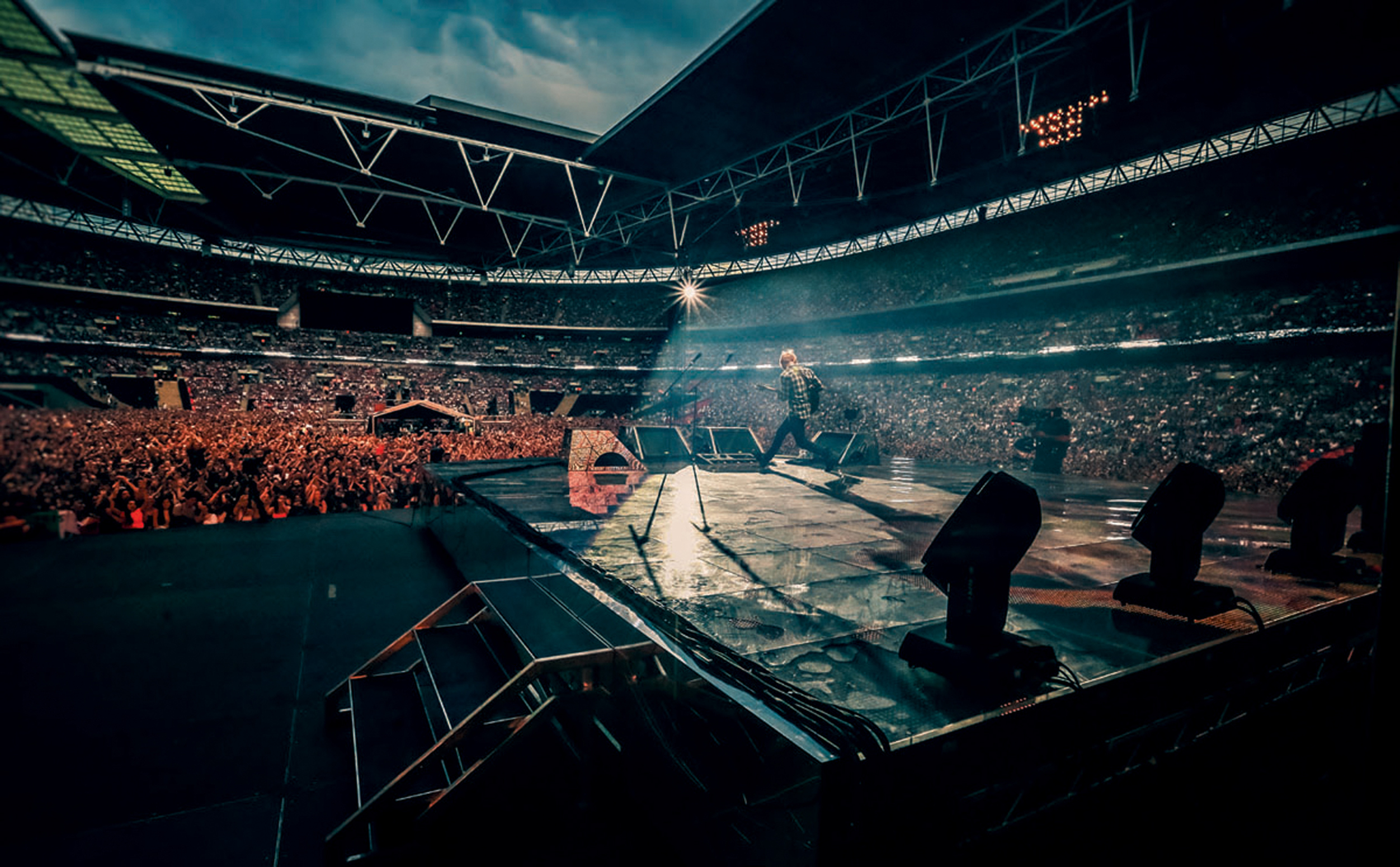
John Sheeran
At last Ed is onstage and he immediately kicks off with a lively opener to get everyone on to their feet singing. The first song and its reception are crucial for setting the mark for the rest of the gig. But there is still daylight. The atmosphere is always greater when it’s dark.
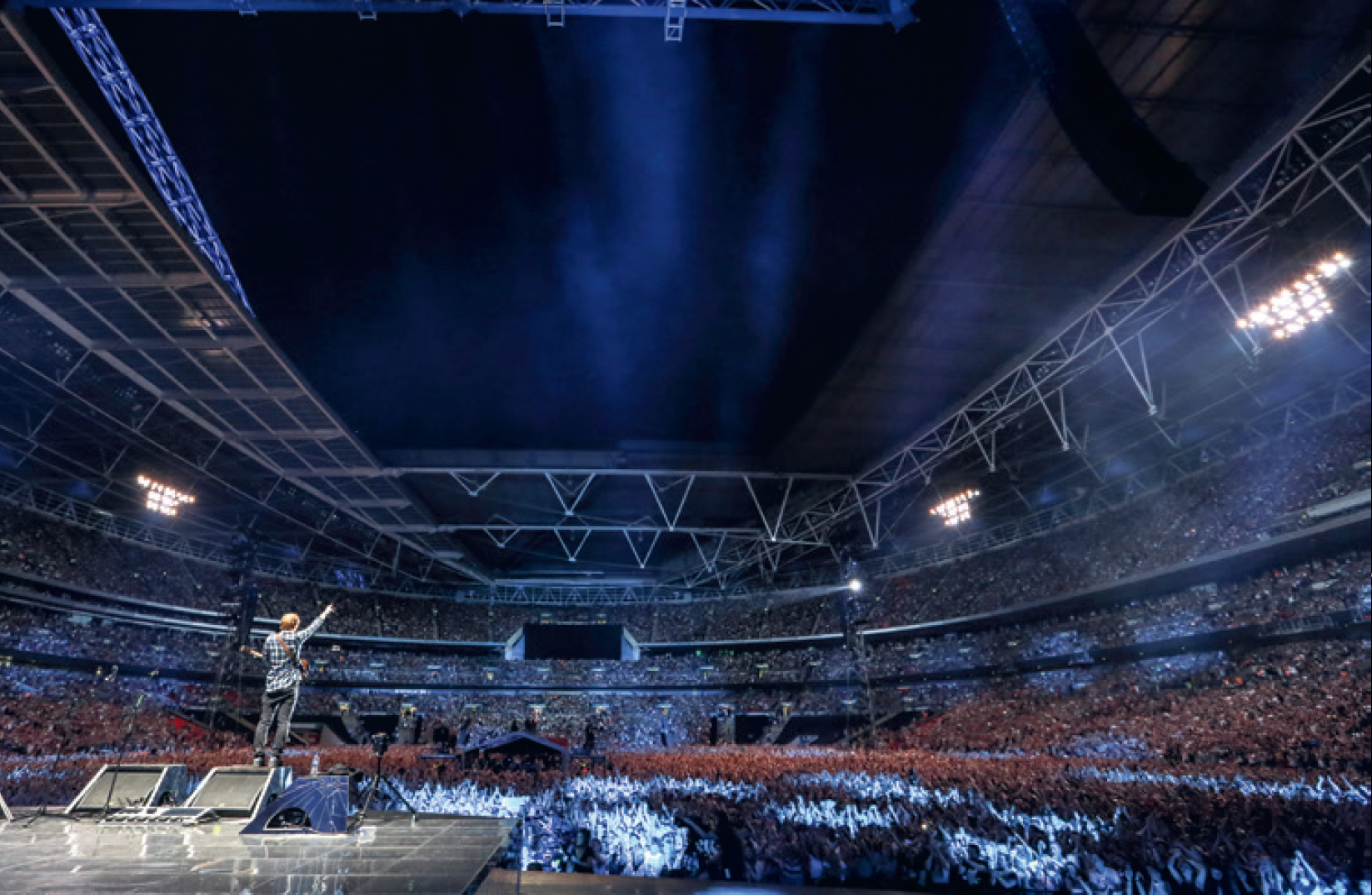
John Sheeran
This photo gives a great sense of what Ed experiences from the stage: the frightening immensity of Wembley, the surging movement and energy of an enormous crowd, and a non-stop lighting extravaganza. Viewing this photo, we, of course, can’t hear the sound of the music or the thousands of voices singing his words back to him, but nevertheless it powerfully captures the atmosphere and the uniqueness of the occasion.
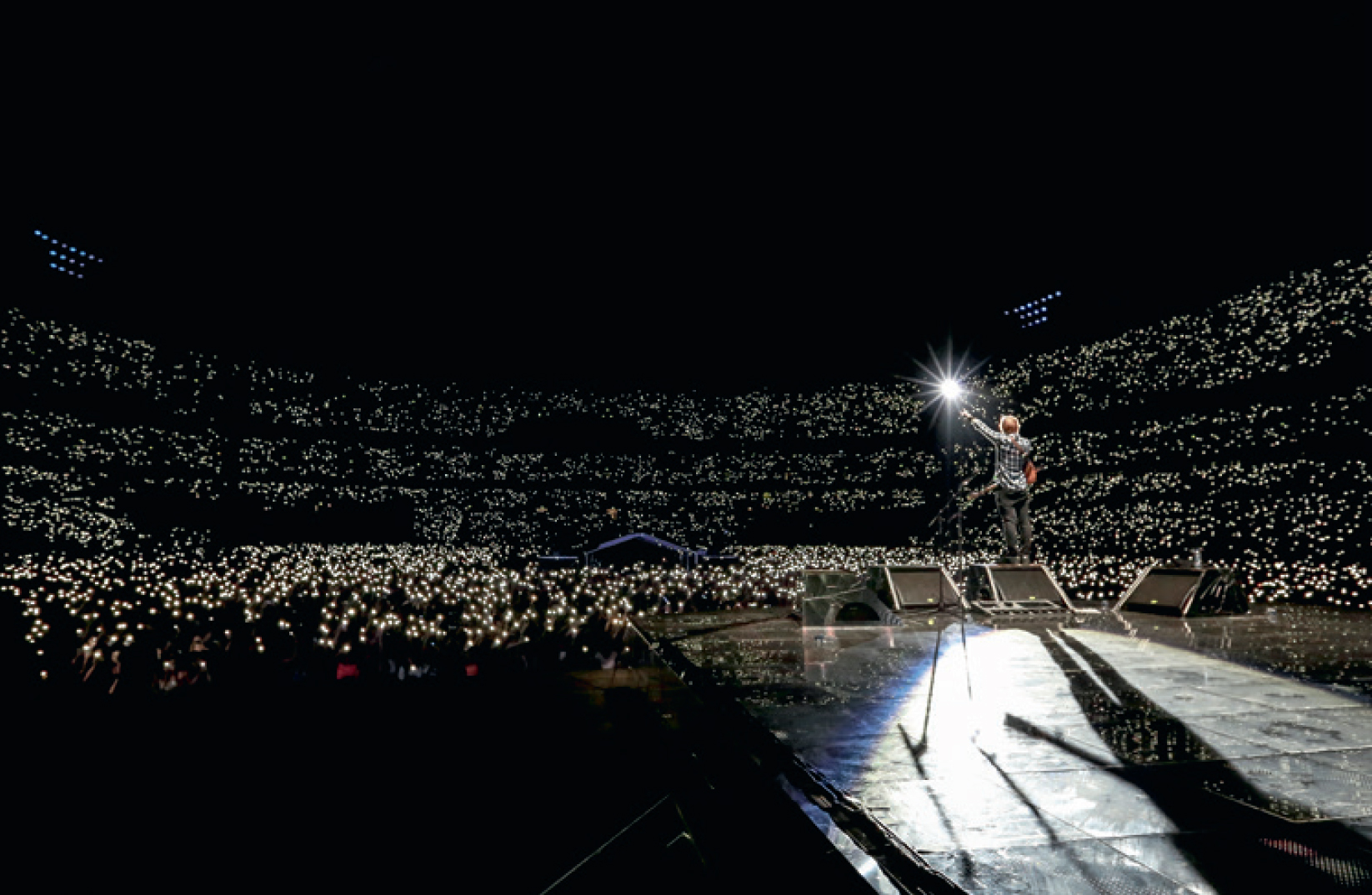
John Sheeran
This is an iconic image that sums up everything Ed stands for. He’s performing all alone, commanding a vast crowd, with the lights of thousands of mobile phones shining like stars in a night sky. And the brightest star of all, a distant spotlight, illuminates him and casts his long shadow back over the huge stage.
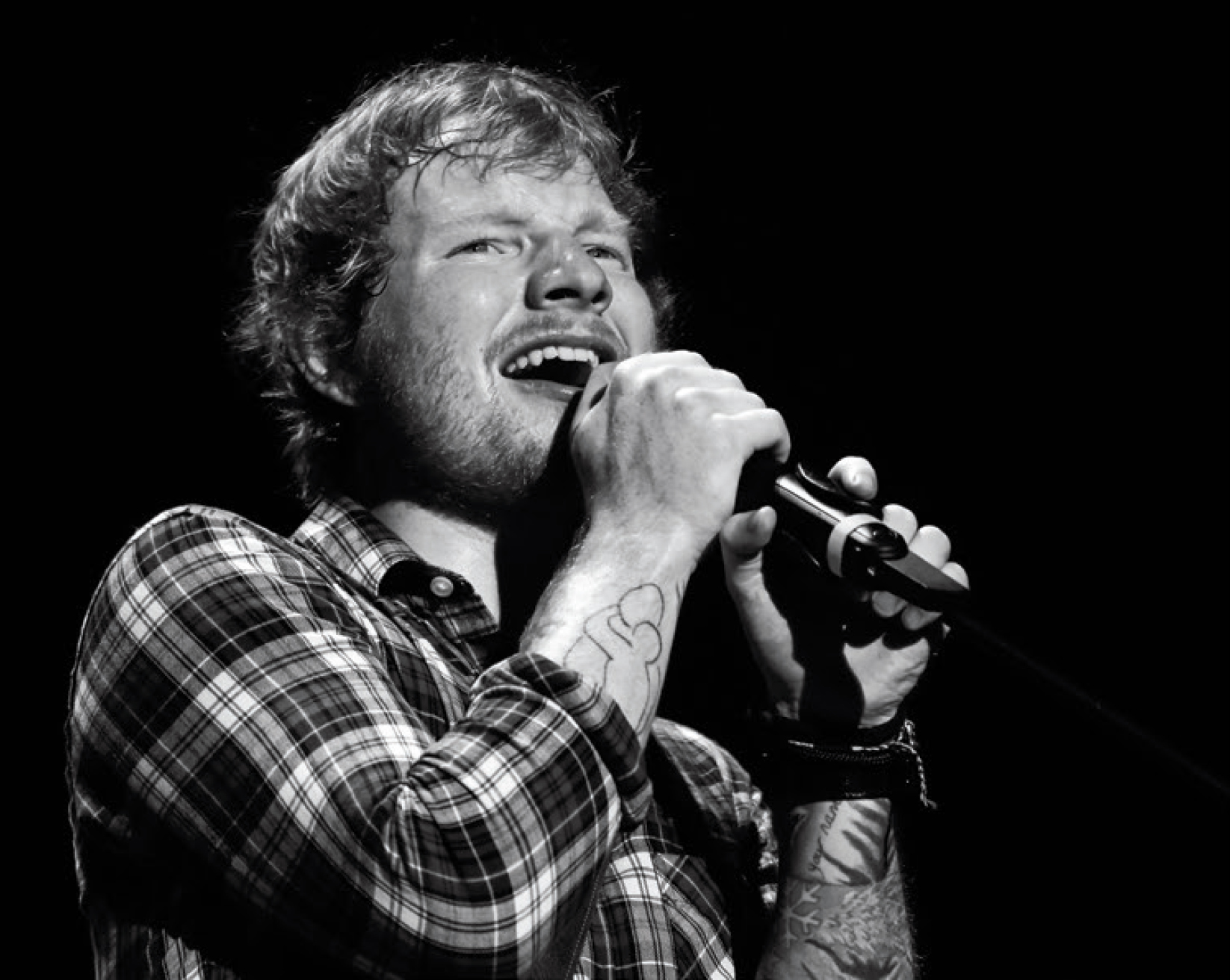

I am often told: “You really captured the essence of so-and-so in that shot.” As flattering as that may sound, I don’t buy into the whole “capturing a person in one picture” deal. I can only hope there are many more aspects to me as a person than one single image can portray. We are all multifaceted, complex human beings, and maybe it takes a book full of pictures to capture the essence of a person. When shooting Ed, that has always been my focus. Whether I shoot him live onstage or I am shooting him backstage, performing or posing, they each are a facet of Ed. That is Ed the performer. I also want to capture those moments that make him unique, that make him the Ed I know. You will often find me sitting back and just observing people. When I shoot a live concert from the pit, I never stop shooting because it is often in the moments in between songs, when their performance button is switched off, that for just a second or two I can capture another facet of that person onstage. Those are often the most significant moments to capture if you want to get the full picture. It’s all about observing attentively.
Another question I often get asked is: “What makes a great photograph?” I don’t think you can answer that. Whatever a great photograph is to you might not be the same to the person next to you. It’s very subjective. It depends on your emotions and what you feel when you look at a photograph. A photo can be great because of its structure and composition, because it’s set in an enchanting decor, or just because of who is in it and how you feel about that person. Sometimes a photo that I think is great is more about what happened when I was taking the picture: if what I felt comes back when I look at the photo later.
That said, I can give an answer to the question :“How do you learn to take great photographs?” It is all about observing people and what is going on around you. There is a difference between seeing and observing. Most people, when they look through their viewfinder, just see what is right in front of them. I often tell students who want to take up music photography that it doesn’t matter whether you have the best equipment that money can buy. If you don’t learn to really observe, then that great picture you want to take will escape you.
I’d like to use the example of Ed’s first Wembley Stadium show in 2015. For me at that time it was important to shoot Ed in context with the epic magnitude of the stadium he was in. It was the epitome of his career up to that point and that is what I wanted the picture to show. Wembley Stadium is impressive in its size, and the sea of excited fans was just mind blowing. So, I had to just capture exactly that, framing Ed with the imposing stadium as the background. But as I climbed the ramp at the back of the stage and peeked in between the screens and lights, and took in the view, what actually struck me more than the immense scale of the stadium was the size of the stage. It was enormous, a huge surface of some kind of hard transparent plastic, with lights underneath shining up – quite ingenious, with an exciting, futuristic feel to it. It felt a bit like I was standing on the threshold of a sci-fi spaceship. Ed was standing right at the end of the stage near the crowd with his pedal board in front of him. From where I was standing the stage felt just infinite, like there was no end to it. So that was when I decided that what I had to capture was the sheer magnitude of the event. That is why I didn’t zoom in more tightly on Ed. I just kept shooting wide-angle shots and let the stage with the stadium as backdrop do all the work. I made sure that, as much as possible, I had almost the whole stage in my frame, and left it bleeding off the frame left and right. That shot where almost half the picture is taken up by the immense stage encapsulates the importance of what happened that day. That was Ed conquering Wembley Stadium.
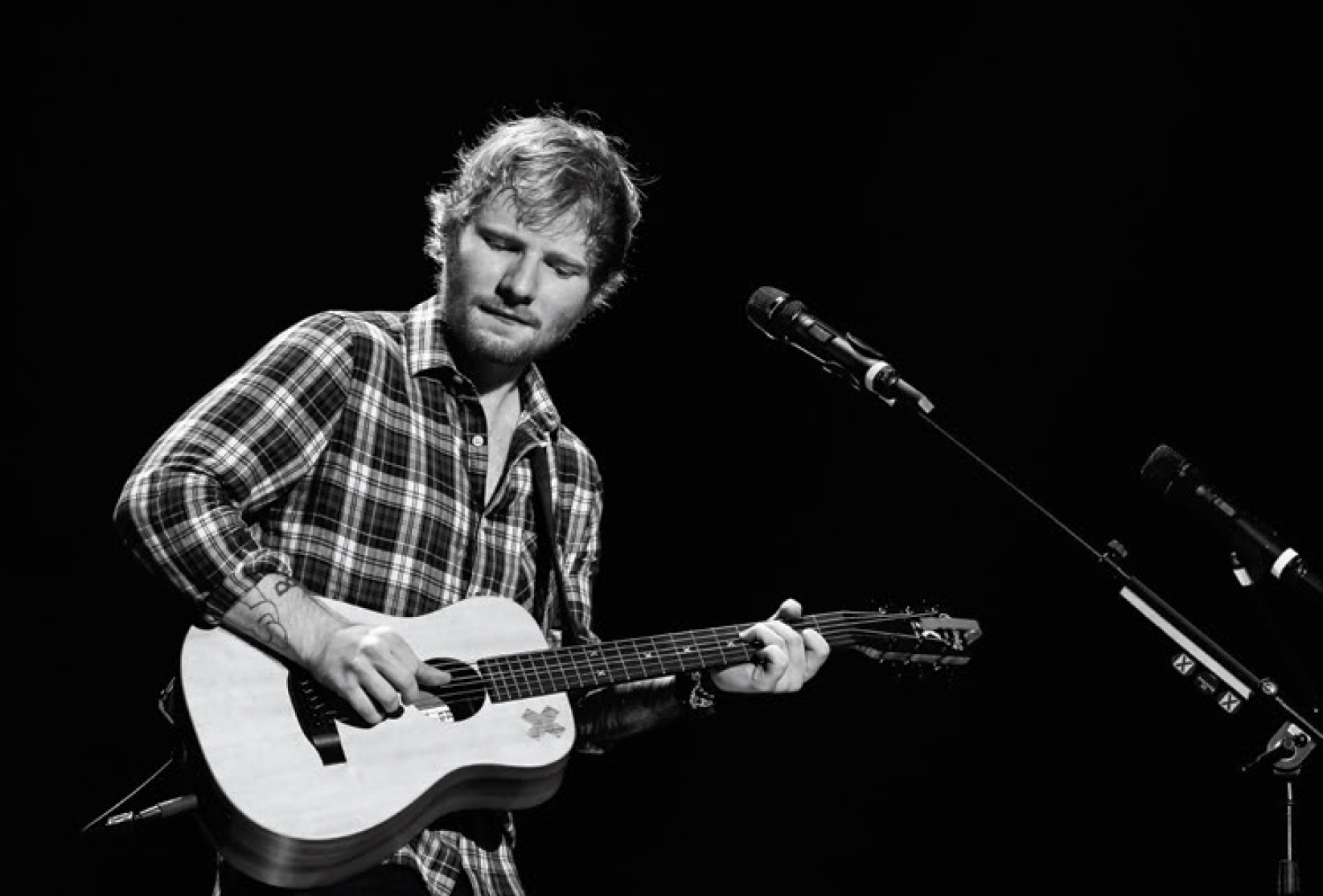
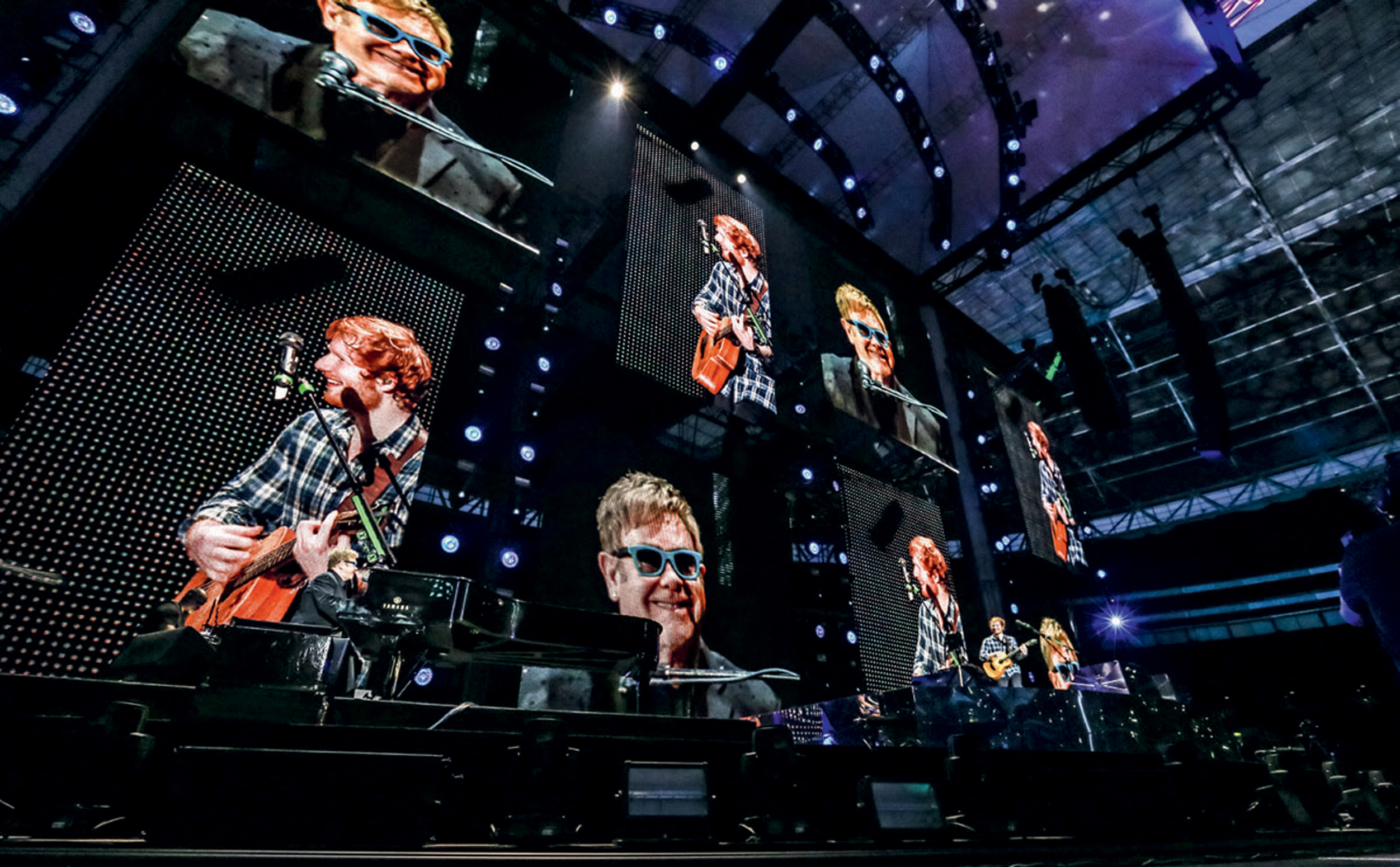
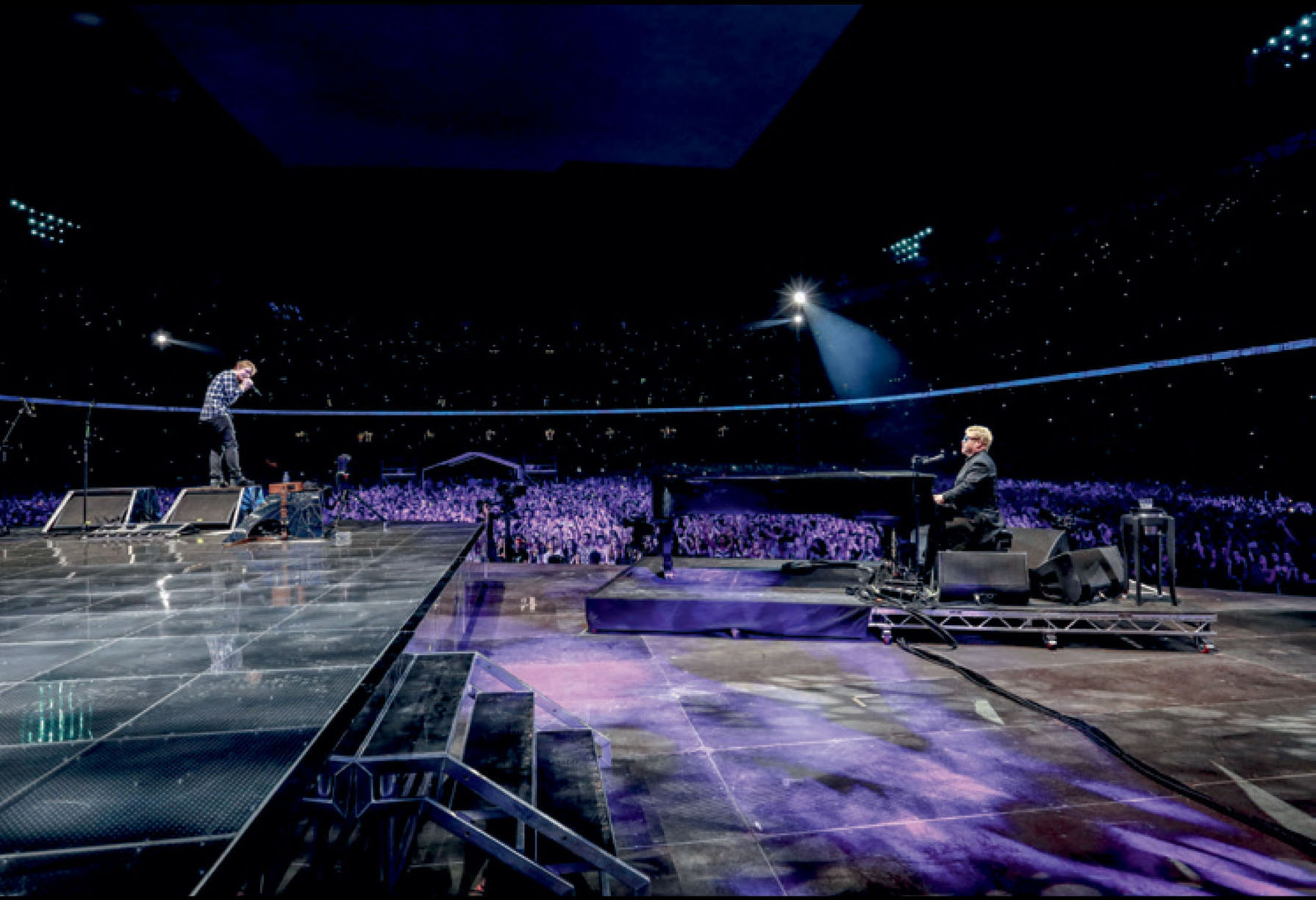
Christie Goodwin
I’ve chosen this Wembley picture because I like how we can be a witness to Ed and Elton sharing the stage from up close. Elton John joined Ed for two songs, and the first song I had shot from the pit. After the first song, I ran up to the back of the stage and shot the rest from behind the screens. I waited patiently for this moment when Elton looked up toward Ed and Ed was turned toward Elton. Sometimes, patience is all it takes to get the best shots.
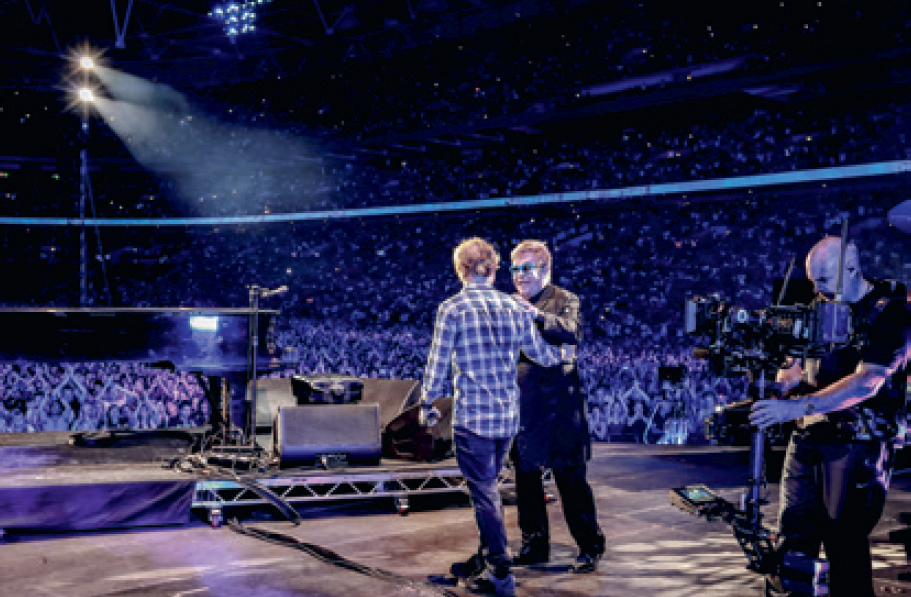
John Sheeran
It really doesn’t get any better than this: seeing your son perform at Wembley with Elton John. I remember vividly the incredible reception Elton got from the crowd when he joined Ed onstage. And when they started to sing “Don’t Go Breaking My Heart”, I sensed a heartfelt exhilaration sweeping through the vast stadium. The shot of the two of them against the huge backdrop of live screens is magnificent. Both have big grins on their faces and they are obviously having a ball performing together. Then you see them embracing afterward, with the crowd ecstatic in the background, and the cameraman recording it all for posterity. It means so much to me that the heroes of my teens and twenties are now Ed’s heroes too. He gets on so well with many of the greats, like Paul McCartney, Paul Simon and Van Morrison, and has performed with Eric Clapton, the Rolling Stones and Stevie Wonder. It is just remarkable.
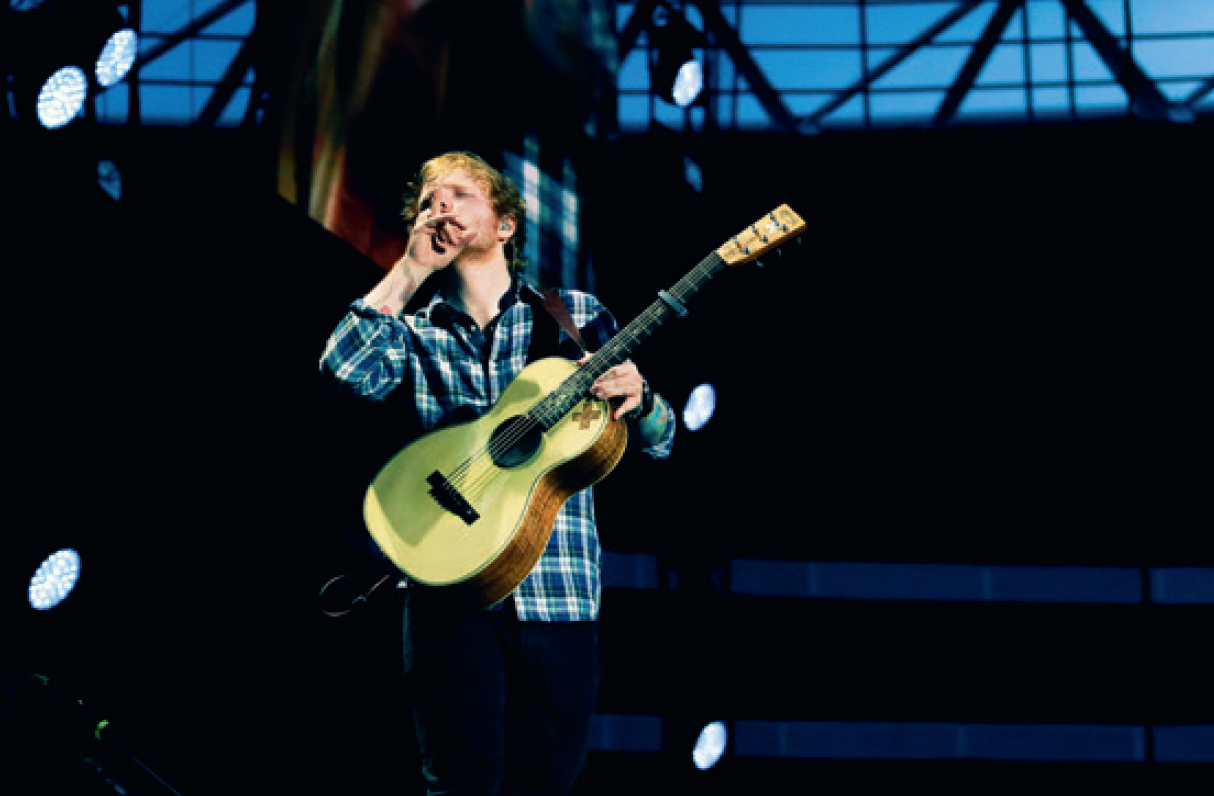
John Sheeran
Earlier in this book, we saw Ed trying to hush the audience at the Royal Albert Hall. Now he is attempting it at Wembley Stadium! This is a photo that illustrates Ed’s limitless, positive ambition. Everything seems possible to him.
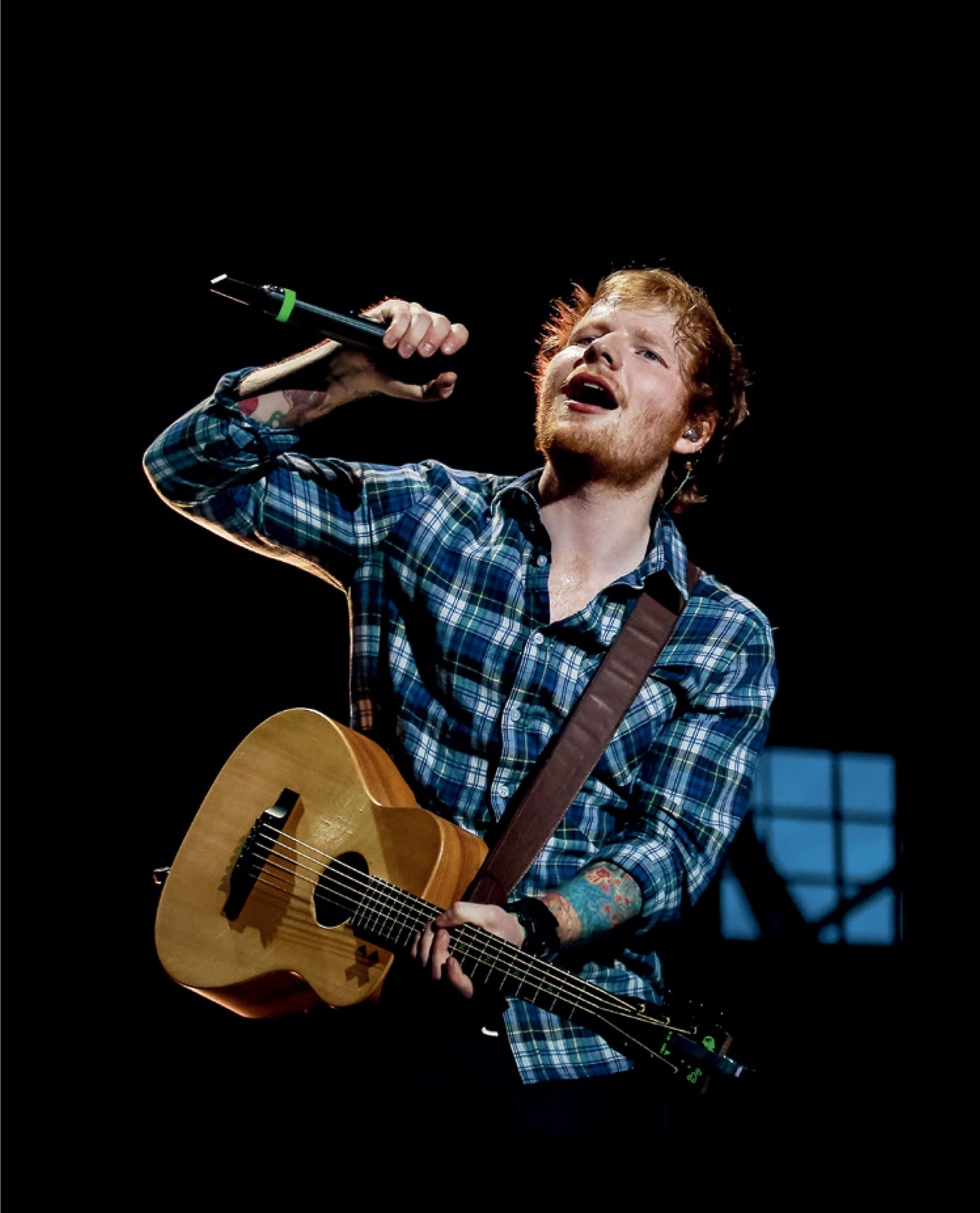
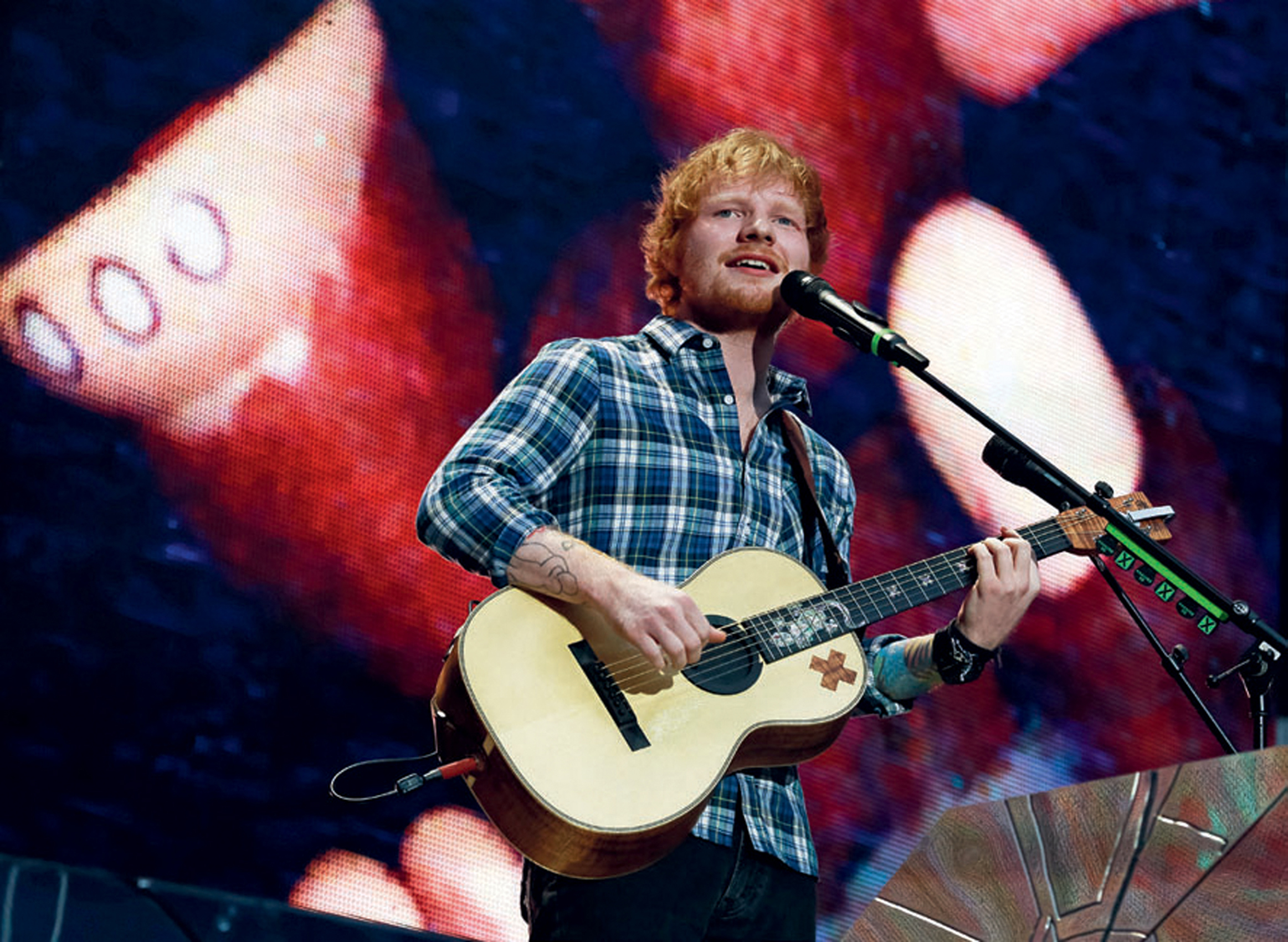
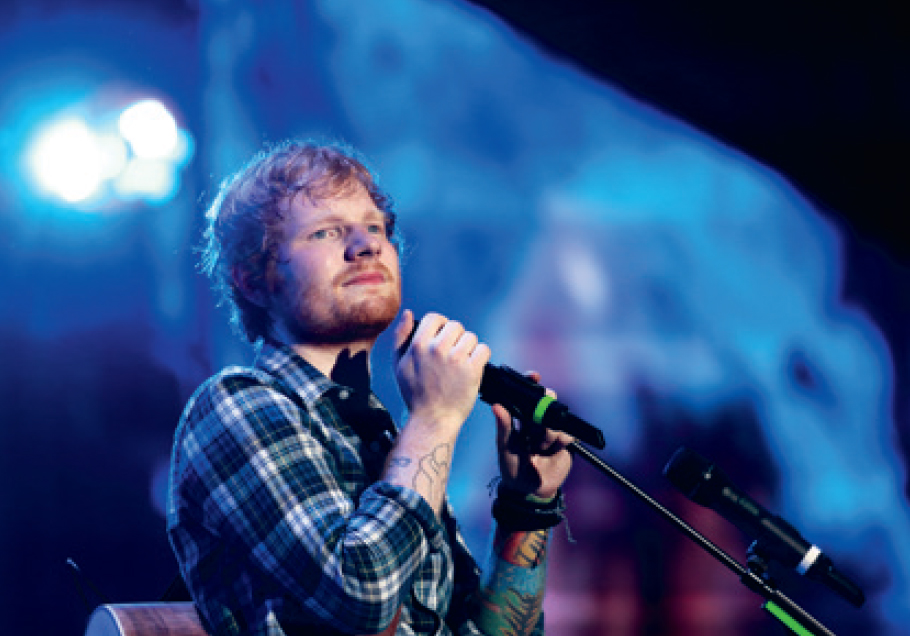
John Sheeran
This photo captures a moment of stillness and contemplation amid the euphoria of Ed’s Wembley performance.
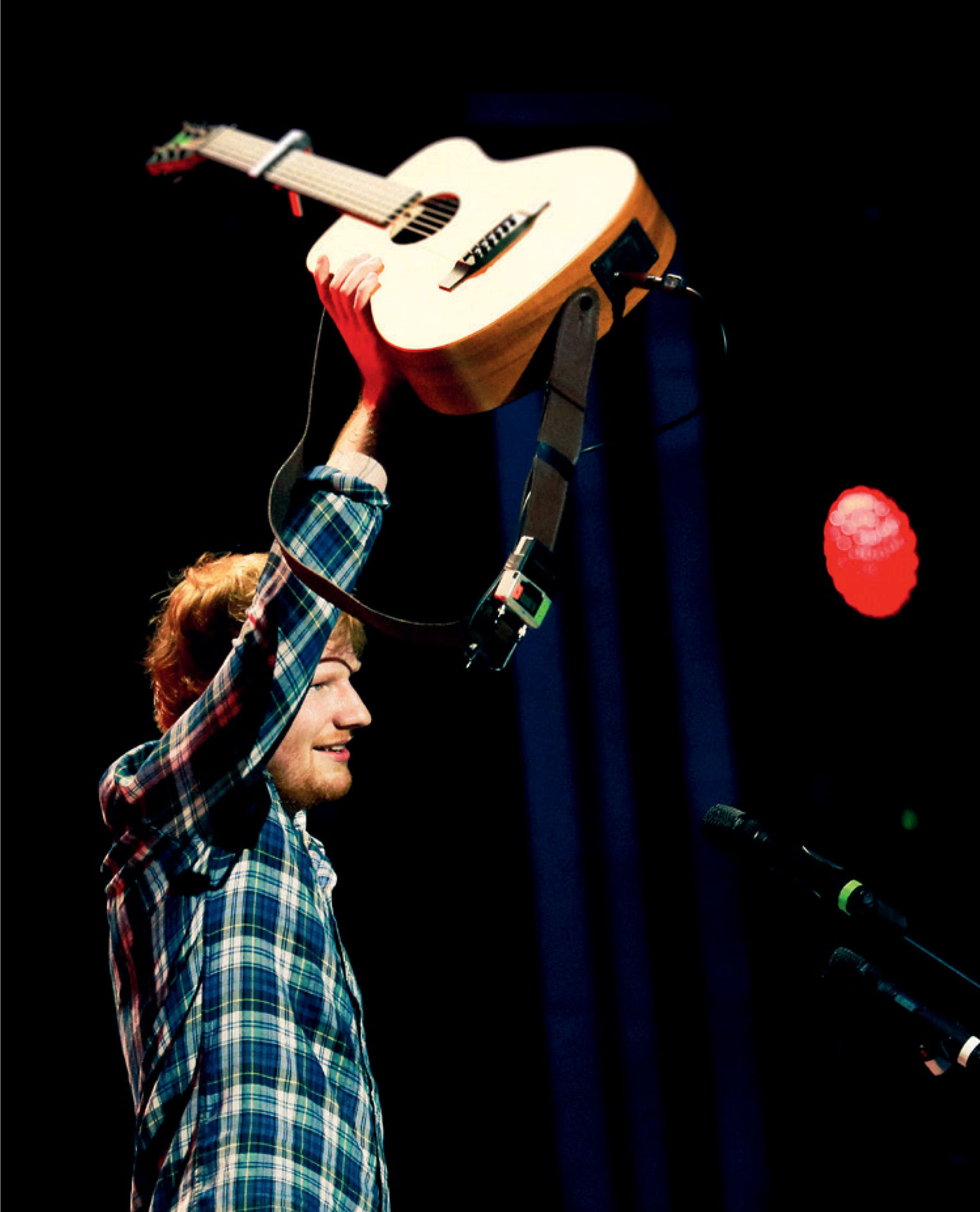
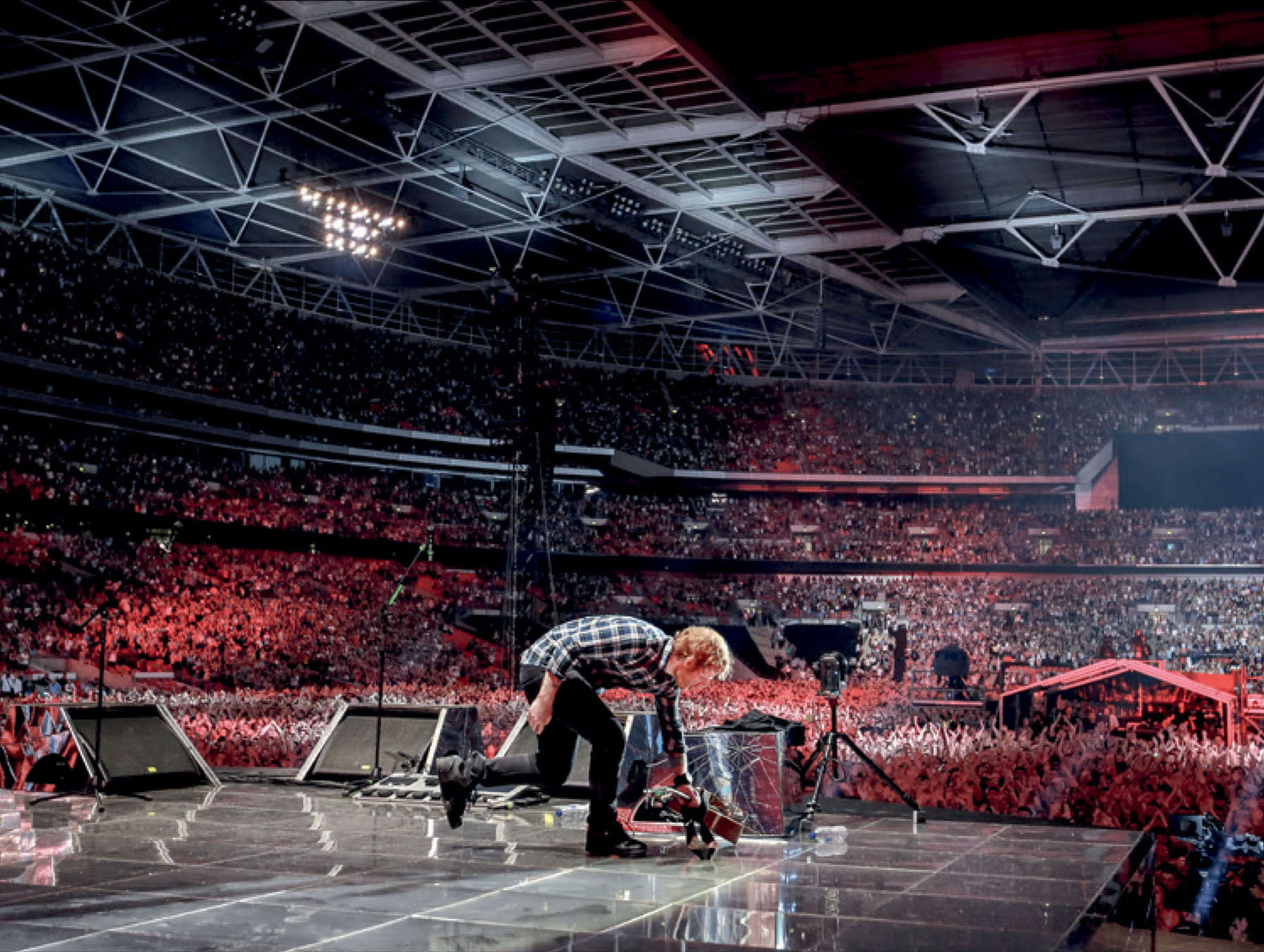
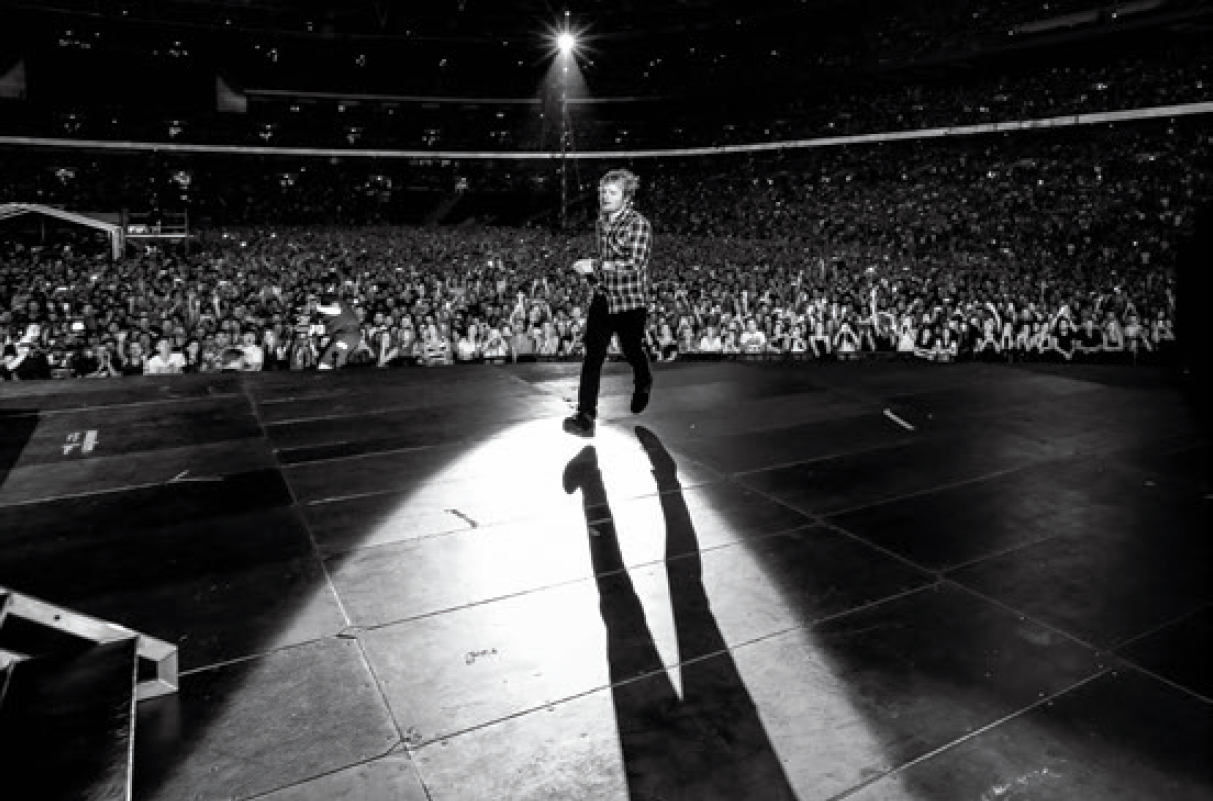
Christie Goodwin
This is my favourite picture of that evening at Wembley Stadium. It all seems pretty straightforward but nothing is what it seems. The spotlight behind Ed was constantly moving, and my aim was to capture Ed when that spot would be just at the right place so it would cast an almost perfect shadow on to the floor. The reason why I like this picture so much is that I did manage to get it right, with the spot draping a fine shadow across the floor, but while doing so I also caught Ed mid-air as if he is flying over the stage. I love it when things come together like this.
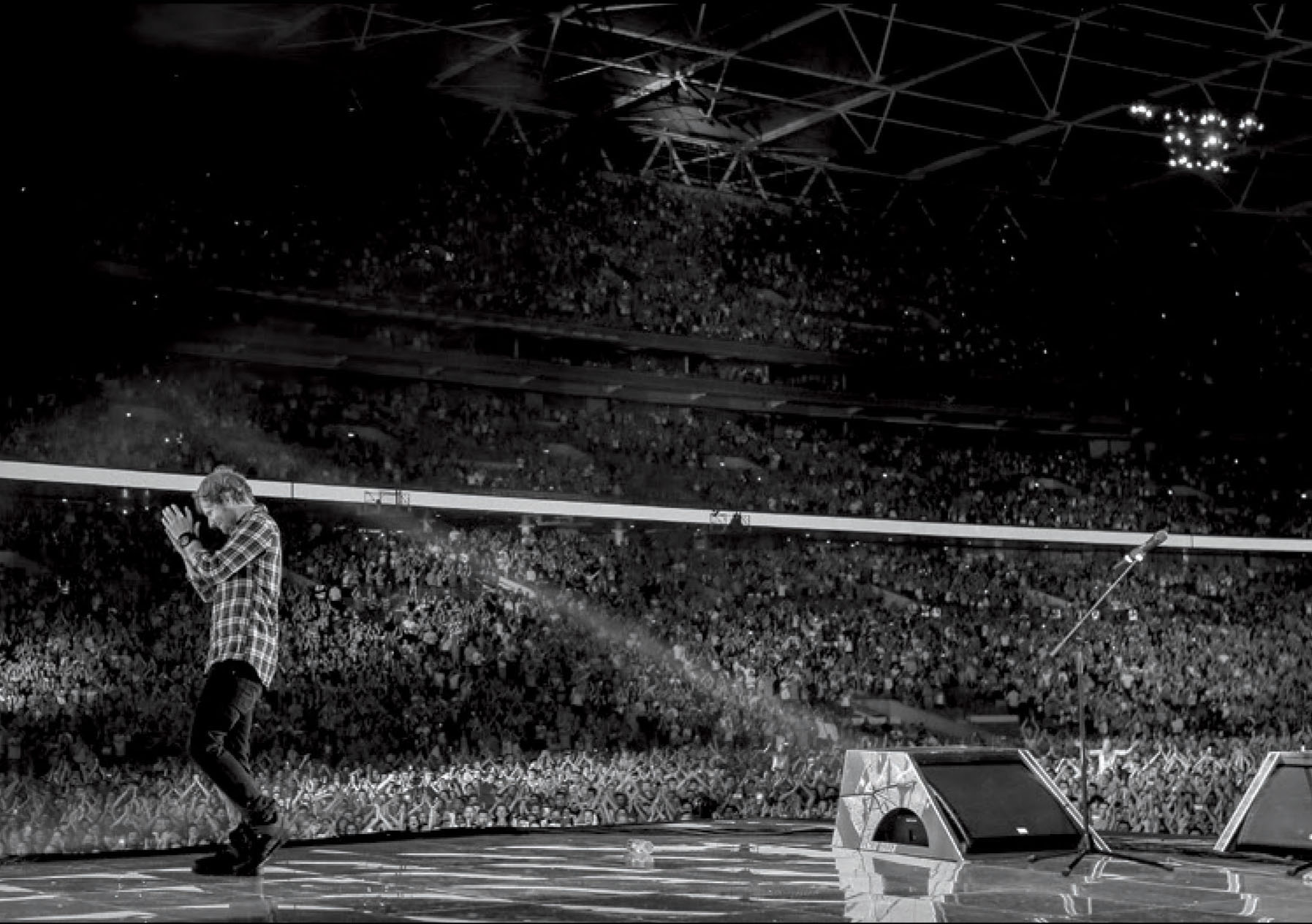
John Sheeran
It is the end of the show. Ed has the Wembley crowd singing and clapping. He is taking his leave and he has a broad smile on his face. Before he went onstage, his body language and his expression revealed his doubt and nerves. But it’s all over now and he’s proved to himself that he can do it, and he will be back for two more nights. The illuminated line that runs all the way around the inside of Wembley Stadium leads to his head and to his expression of relief and joy. Even one of the stage lights seems to follow and salute him.